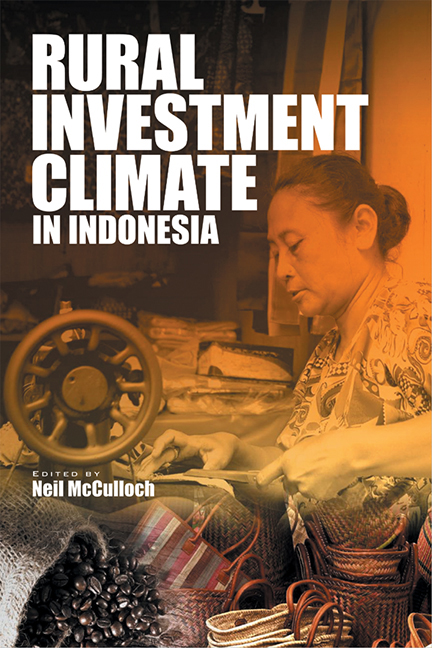Book contents
- Frontmatter
- Contents
- List of Tables, Figures, and Boxes
- Abbreviations and Acronyms
- The Contributors
- 1 Introduction
- 2 Agricultural Demand Linkages and Growth Multipliers in Rural Indonesia
- 3 Trends and Constraints Associated with Labour Faced by Non-Farm Enterprises
- 4 The Constraints in Accessing Credit Faced by Rural Non-Farm Enterprises
- 5 The Constraints Associated with Infrastructure Faced by Non-Farm Enterprises at the Kabupaten Level
- 6 Technology/Knowledge Transfer and Diffusion in Indonesian Non-Farm Enterprises
- 7 Marketing and Competition in the New Indonesia
- 8 Local Tax Effects on the Business Climate
- 9 Leadership and Voice in Local Governance
- 10 Insecurity and Business Development in Rural Indonesia
- Index
2 - Agricultural Demand Linkages and Growth Multipliers in Rural Indonesia
Published online by Cambridge University Press: 21 October 2015
- Frontmatter
- Contents
- List of Tables, Figures, and Boxes
- Abbreviations and Acronyms
- The Contributors
- 1 Introduction
- 2 Agricultural Demand Linkages and Growth Multipliers in Rural Indonesia
- 3 Trends and Constraints Associated with Labour Faced by Non-Farm Enterprises
- 4 The Constraints in Accessing Credit Faced by Rural Non-Farm Enterprises
- 5 The Constraints Associated with Infrastructure Faced by Non-Farm Enterprises at the Kabupaten Level
- 6 Technology/Knowledge Transfer and Diffusion in Indonesian Non-Farm Enterprises
- 7 Marketing and Competition in the New Indonesia
- 8 Local Tax Effects on the Business Climate
- 9 Leadership and Voice in Local Governance
- 10 Insecurity and Business Development in Rural Indonesia
- Index
Summary
Background
Although declining, rural areas still make up an important part of the Indonesian economy. The majority of Indonesians still live in rural areas. According to data from the Population Census 2000, around 58 per cent of Indonesians are rural residents. Aside from providing food supplies for the whole economy, the rural areas also contribute importantly to foreign exchange earnings from export of commodities. However, rural areas apparently lag behind compared to urban areas, both in terms of physical infrastructure as well as the socio-economic welfare of the populace. As a consequence, around 80 per cent of all the poor in the country are found in rural areas.
This obviously calls for more focused attention and more rigorous efforts on rural development. This, however, requires a clear and effective strategy to jump-start and sustain economic growth in rural areas. Since rural areas are closely identified with the agricultural sector, a more specific question is whether investments should be directed to improve productivity in the agricultural sector or whether it is more effective to invest to develop the rural non-agricultural sector directly. Ultimately, the answer to this question, and hence the rural development strategy adopted, should depend on its potential to push growth for the whole rural economy.
The agricultural and non-agricultural sectors in rural areas are closely linked. Hence, growth in one sector will induce growth in the other. However, despite the fact that there is a relatively long history of studies focusing on the subject of rural sectoral linkages, there remains debate on whether the most effective route for rural development is through firstly developing the agricultural sector or through directly developing the nonagricultural sector.
Among one strand of the literature, there is a consensus that agriculture has strong linkages and has a large growth multiplier to other sectors in the rural economy and, because of that, it is essential to develop the agriculture sector first in order to develop the whole rural area. Not all rural development thinkers and practitioners agree to the agriculture-first strategy, however. Some have argued for the opposite, that it is the non-agriculture sectors that have strong potential to push economic growth in the rural areas and pull the poor, who mostly live in the agriculture sector, out of poverty.
- Type
- Chapter
- Information
- Rural Investment Climate in Indonesia , pp. 24 - 49Publisher: ISEAS–Yusof Ishak InstitutePrint publication year: 2009



